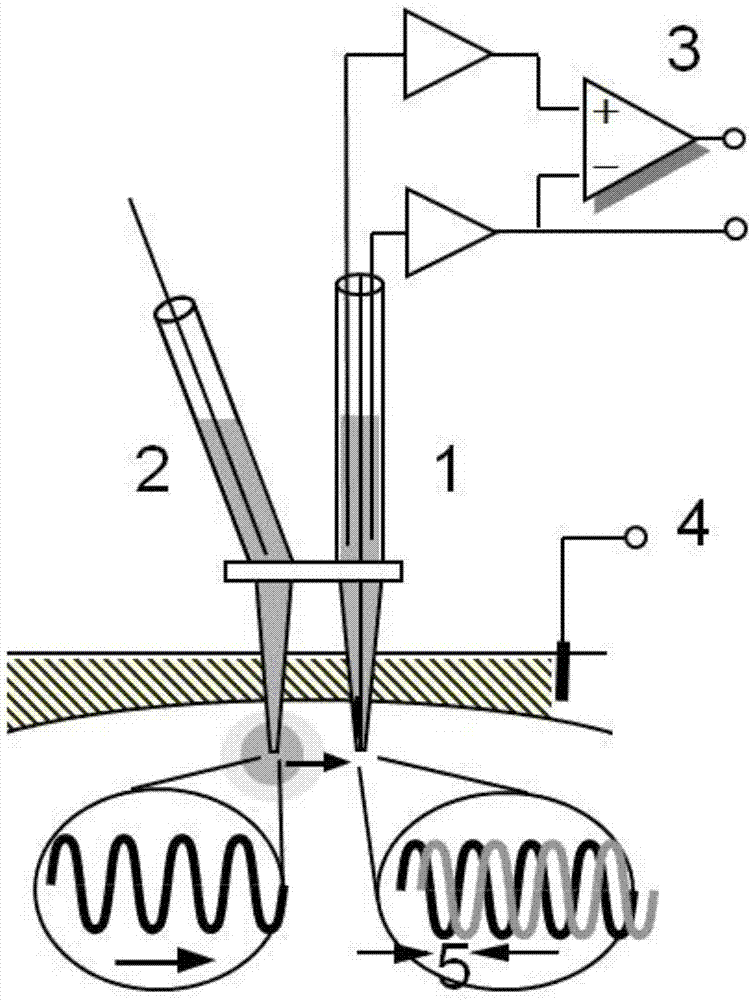A method for real-time monitoring of dynamic changes in the extracellular space of animal brain tissue
A technology of real-time monitoring and extracellular space, applied in the field of neurophysiological medicine, can solve the problems of large errors, influence, and inability to correctly monitor the dynamic changes of the extracellular space of the brain, and achieve the effect of enhancing physiological stress response
- Summary
- Abstract
- Description
- Claims
- Application Information
AI Technical Summary
Problems solved by technology
Method used
Image
Examples
Embodiment 1
[0035] A computer model is used to verify the feasibility and accuracy of the phase shift method.
[0036] 1. If image 3 As shown, α(z,t) and λ(z,t) constructed in computer simulation are not only functions of time but also functions of one-dimensional space z.
[0037] 2. If image 3 As shown, the change of α(z,t) and λ(z,t) simulates a pathological state: Spreading Depression (Spreading Depression, a common pathological state), and it is assumed that the spreading depression is one-dimensional propagation, and the propagation speed u is 2.5mm / min, the time-space function graph of propagation is as follows image 3 Ψ(ξ) in 7, the simulated Ψ(ξ) function includes a square wave representing a sharp change in the extracellular structure and a sine wave with a soft change.
[0038] 3. The setting of different boundary conditions in the model can simulate the diffusion experiment in the extracellular space in body tissue (without diffusion boundary) or brain slice (with diffus...
Embodiment 2
[0046] Real-time monitoring of extracellular structural changes in the cortex of live-anesthetized rats during the onset of propagating inhibition.
[0047] 1. Sprague-Dawley adult rats (200-300 grams in weight) were intraperitoneally anesthetized with chloral hydrate, fixed their heads on a stereotaxic device, and opened a window with a diameter of 5 cm above the body motor cortex with a skull drill.
[0048] 2. Insert the potassium ion selective electrode, the ion probe (tetramethylammonium ion) release electrode-ion probe detection electrode array, and the reference electrode at 1 cm below the cortex with a micromanipulator.
[0049] 3. Select a specific frequency ω (frequency range is 0.04 ~ 0.25Hz) and phase difference ε, start the ion electrophoresis instrument according to the formula (1) and start synchronous ion probe extracellular concentration and field potential recording. After the stabilization of the standby potential, potassium ion and ion probe recordings, the...
Embodiment 3
[0060] Real-time monitoring of brain extracellular structural changes in isolated rat brain slices during the occurrence of propagating inhibition.
[0061] 1. Sprague-Dawley adult rats were intraperitoneally anesthetized with chloral hydrate (400 mg / kg), decapitated their heads, and cut their brains into 400-micron-thick slices at freezing temperatures.
[0062] 2. Place the cut brain slices in a fully immersed brain slice recording tank, perfuse with artificial cerebrospinal fluid containing 0.5mM tetramethylammonium with oxygen, and reincubate the brain slices at room temperature for 1 hour.
[0063] 3. Insert the potassium ion selective electrode, ion probe (tetramethylammonium ion) release electrode-ion probe detection electrode array, and reference electrode into the neocortex with a micromanipulator, approximately below the surface of the brain slice 200 μm, at least 1 cm away from the edge of the brain slice.
[0064] 4. Perform the phase shift method to record and in...
PUM
 Login to View More
Login to View More Abstract
Description
Claims
Application Information
 Login to View More
Login to View More - R&D
- Intellectual Property
- Life Sciences
- Materials
- Tech Scout
- Unparalleled Data Quality
- Higher Quality Content
- 60% Fewer Hallucinations
Browse by: Latest US Patents, China's latest patents, Technical Efficacy Thesaurus, Application Domain, Technology Topic, Popular Technical Reports.
© 2025 PatSnap. All rights reserved.Legal|Privacy policy|Modern Slavery Act Transparency Statement|Sitemap|About US| Contact US: help@patsnap.com



